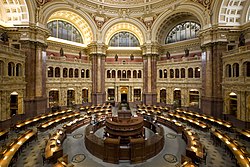Our website is made possible by displaying online advertisements to our visitors.
Please consider supporting us by disabling your ad blocker.
Library of Congress
| Library of Congress | |
|---|---|
 | |
 Main reading room of the Library's Thomas Jefferson Building | |
| 38°53′19″N 77°0′17″W / 38.88861°N 77.00472°W | |
| Location | Washington, D.C. |
| Established | April 24, 1800 |
| Collection | |
| Size | 173 million items[a] |
| Access and use | |
| Circulation | Onsite use only |
| Population served | Congress, citizens, and international visitors |
| Other information | |
| Budget | $802.128 million[2] |
| Director | Carla Hayden |
| Employees | 3,105[2] |
| Website | loc |
The Library of Congress (LOC) is a research library in Washington, D.C., that serves as the library and research service of the U.S. Congress and the de facto national library of the United States.[3] Founded in 1800, the library is the United States's oldest federal cultural institution.[4] The library is housed in three elaborate buildings on Capitol Hill. It also maintains a conservation center in Culpeper, Virginia.[5] The library's functions are overseen by the Librarian of Congress, and its buildings are maintained by the Architect of the Capitol. The Library of Congress is one of the largest libraries in the world.[3][6] Its collections contain approximately 173 million items, and it has more than 3,000 employees. Its collections are "universal, not limited by subject, format, or national boundary, and include research materials from all parts of the world and in more than 470 languages".[4]
Congress moved to Washington, D.C., in 1800 after holding sessions for eleven years in the temporary national capitals in New York City and Philadelphia. In both cities, members of the U.S. Congress had access to the sizable collections of the New York Society Library and the Library Company of Philadelphia.[7] In Washington, the library was housed in the United States Capitol for almost all of the 19th century. Much of the library's original collection was burnt by British forces during the War of 1812. Congress then purchased Thomas Jefferson's entire personal collection of 6,487 books to restore its own collection. Over the next few years, its collection slowly grew; in 1851, another fire broke out in the Capitol chambers. This destroyed a large amount of the collection, including many of Jefferson's books.
After the American Civil War, the importance of the Library of Congress for legislative research increased and there was a campaign to purchase replacement copies for volumes for its lost books. The library received the right of transference of all copyrighted works, and deposit of two copies of books, maps, illustrations, and diagrams printed in the United States. The Library also built its collections through acquisitions and donations. Between 1888 and 1894, Congress constructed and moved the collection to a large adjacent library building, now known as the Thomas Jefferson Building, across the street from the Capitol. Two more adjacent library buildings, the John Adams Building, built in the 1930s, and the James Madison Memorial Building, built in the 1970s, hold expanded parts of the collection and provide space for additional library services.
The library's primary mission is to research inquiries made by members of Congress, which is carried out through the Congressional Research Service. It also houses and oversees the United States Copyright Office. The library is open to the public for research, although only high-ranking government officials and library employees may borrow (i.e., temporarily take custody of) books and materials.[8]
- ^ "Year 2020 at a Glance". Library of Congress. 2020. Archived from the original on February 23, 2021. Retrieved November 5, 2021.
- ^ a b "2021 Annual Report of the Librarian of Congress" (PDF). Library of Congress. Archived (PDF) from the original on February 3, 2023. Retrieved December 2, 2022.
- ^ a b "Library of Congress". Encyclopædia Britannica. Archived from the original on April 5, 2020. Retrieved September 3, 2017.
- ^ a b "Fascinating Facts". Library of Congress. Archived from the original on April 5, 2020. Retrieved April 25, 2018.
- ^ "General Information". Library of Congress. Archived from the original on February 23, 2021. Retrieved January 28, 2023.
- ^ "Fascinating Facts – Statistics". Library of Congress. Archived from the original on April 5, 2020. Retrieved February 16, 2017.
- ^ "History of the Library of Congress". Library of Congress. Archived from the original on October 6, 2020. Retrieved October 20, 2020.
- ^ "FY 2019–2023 Strategic Plan of the Library of Congress". Library of Congress. Retrieved October 20, 2020.
Cite error: There are <ref group=lower-alpha> tags or {{efn}} templates on this page, but the references will not show without a {{reflist|group=lower-alpha}} template or {{notelist}} template (see the help page).
Previous Page Next Page


